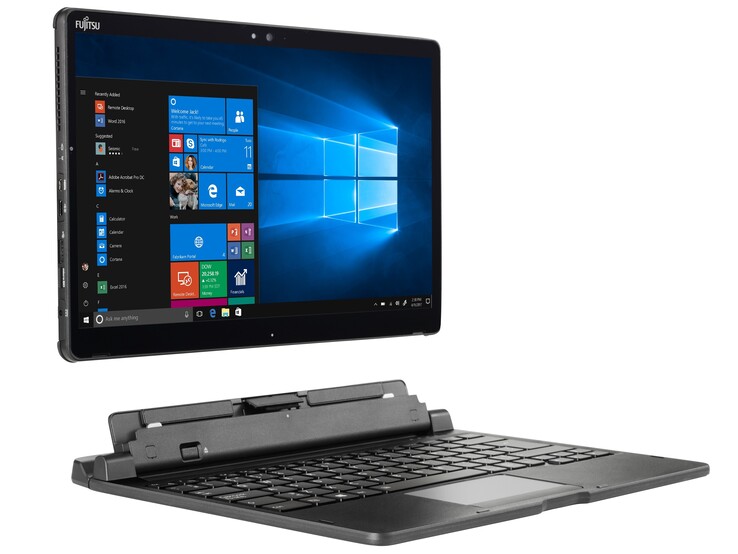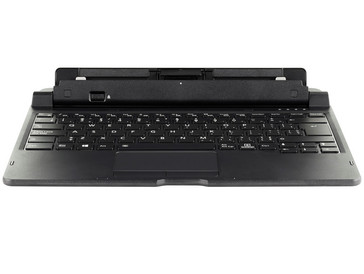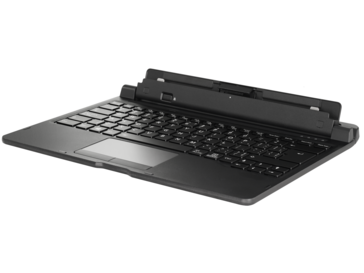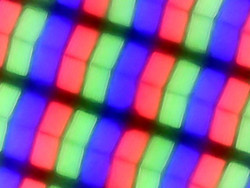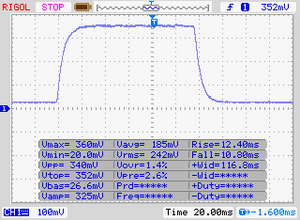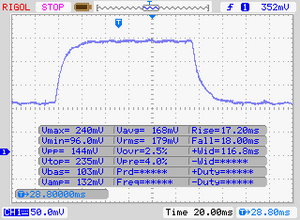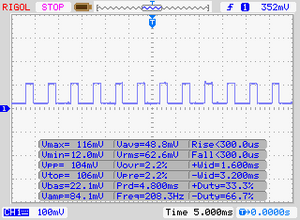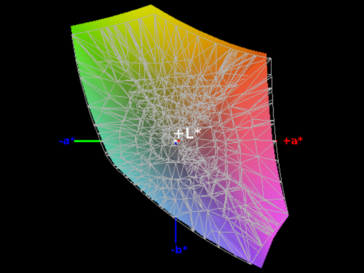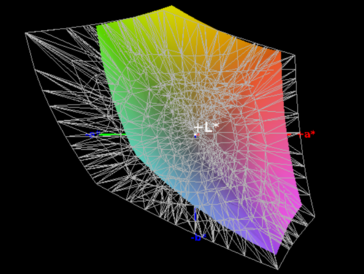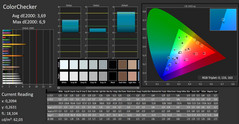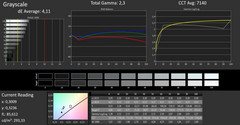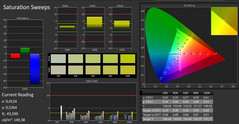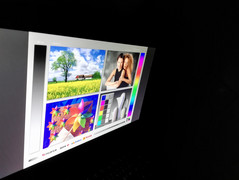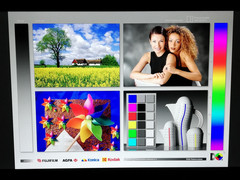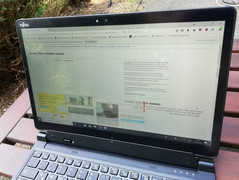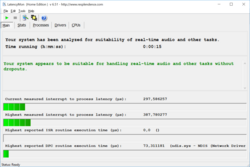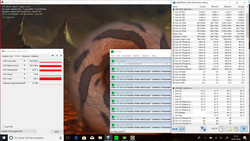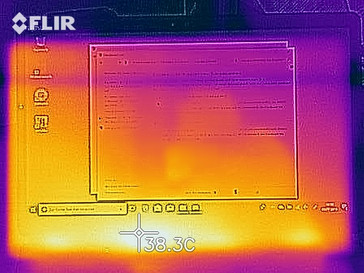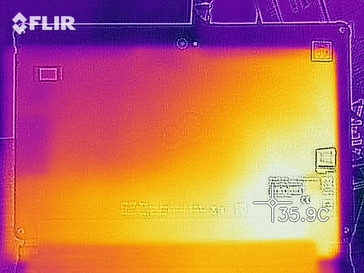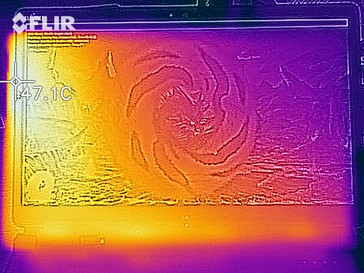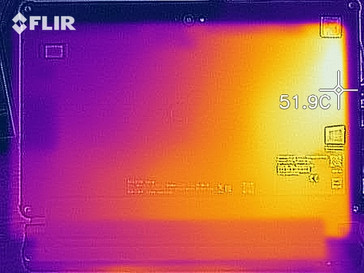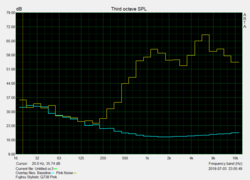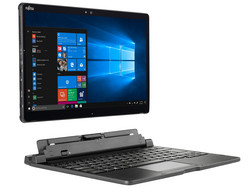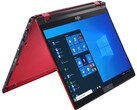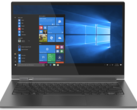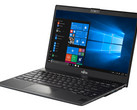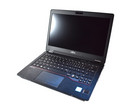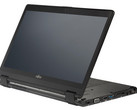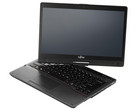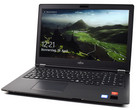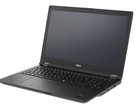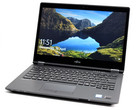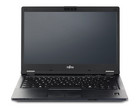Fujitsu Stylistic Q738 (i5-8350U, UHD620) Convertible Review
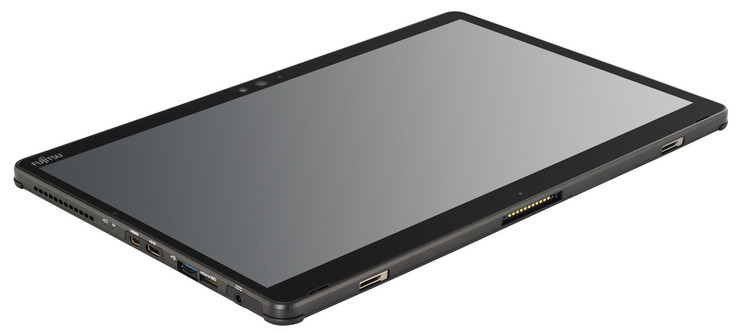
In the realm of convertibles, Fujitsu tends to structure their models somewhat unusually—take, for example, the Fujitsu Lifebook T938 with a revolving display—but the manufacturer also makes foldable devices, like the Fujitsu Lifebook P728. The Fujitsu Stylistic Q738 is the company's foray into the world of convertibles with plug-in keyboards. The new convertible's business features stand out and potentially represent an advantage over the competition.
The features need to stand out, given that other manufacturers offer more performance at a price of around 1600 Euros (~$1875). Our test device is equipped with an Intel Core i5-8350U with an integrated UHD Graphics 620. Some competitors in this price bracket offer a Core i7 processor. With 8 GB of RAM and a 256 GB SSD, the Fujitsu Stylistic Q738 has a solid basis for running office applications.
But at this relatively high price point, the convertible market is thronged with competitors. As a result, the Stylistic tablet will have to prove itself against several devices within the same price bracket, including the Asus ZenBook Flip 15, ThinkPad X380 Yoga, HP Spectre x360 and Acer Spin 5.
Case & Connectivity - Fujitsu tablet with robust case
The Fujitsu Stylistic Q738 has all the connections a tablet might need, and with its thickness of almost a whole centimeter (~0.4 inches), it feels very robust. With the keyboard plugged in, the thickness expands by another 8 millimeters (~0.3 inches). But in exchange, buyers will receive a device that can be used either as a full-fledged laptop or as a business tablet, meaning they will hardly have to make any compromises.
The keyboard component provides just enough counterweight to keep the Stylistic Q738 from tipping over when sitting on a level surface. Experienced users can do a little maintenance work on the Fujitsu convertible by carefully opening the back side, at which point they will have access to all of the machine's inner workings. The fan can be cleaned, and it seems the SSD can also be switched out. On the other hand, we could not find any unoccupied RAM slots.
Due to technical difficulties, we were unfortunately unable to test the device's WLAN speeds— but over the course of our tests, we did not run into any problems with the WLAN connection. In addition to the docking port, below the display users will find a slot for a SIM card. Through this card, the Q738 can establish LTE (Cat. 6) wireless connections and maintain access to the Internet on the go.
Connectivity
| SD Card Reader | |
| average JPG Copy Test (av. of 3 runs) | |
| Fujitsu Stylistic Q738 (Toshiba Exceria Pro M501 microSDXC 64GB) | |
| Average of class Convertible (28.1 - 209, n=23, last 2 years) | |
| Lenovo ThinkPad X380 Yoga 20LJS02W00 (Toshiba Exceria Pro SDXC 64 GB UHS-II) | |
| Asus ZenBook Flip 15 UX561UD (Toshiba Exceria Pro SDXC 64 GB UHS-II) | |
| Acer Spin 5 SP515-51GN-80A3 (Toshiba Exceria Pro SDXC 64 GB UHS-II) | |
| maximum AS SSD Seq Read Test (1GB) | |
| Average of class Convertible (28.9 - 253, n=22, last 2 years) | |
| Lenovo ThinkPad X380 Yoga 20LJS02W00 (Toshiba Exceria Pro SDXC 64 GB UHS-II) | |
| Fujitsu Stylistic Q738 (Toshiba Exceria Pro M501 microSDXC 64GB) | |
| Asus ZenBook Flip 15 UX561UD (Toshiba Exceria Pro SDXC 64 GB UHS-II) | |
| Acer Spin 5 SP515-51GN-80A3 (Toshiba Exceria Pro SDXC 64 GB UHS-II) | |
| Networking | |
| WiFi Speed Client 1m 4M x10 Netgear AX12 | |
| WiFi Speed Server 1m 4M x10 (-R) Netgear AX12 |
Input Devices - Keyboard dock for the Fujitsu Stylistic Q738
The Fujitsu Stylistic Q738 offers a very stable keyboard dock, though it increases the tablet's dimensions substantially. In exchange, users will receive a stable device that bears much similarity to a laptop. The keys are arranged well, and they are of a reasonable size. During typing, however, the feedback is a little too pillowy. The touchpad reacts somewhat slowly, and the separate mouse keys are better for clicking than the pad, given that the pad sometimes fails to recognize input properly.
The touchscreen, on the other hand, does not appear to have any weaknesses. Touch gestures are recognized reliably, and the stylus that comes with the device enables the user to work with precision. Artists and note-takers alike will appreciate the fact that it supports up to 4000 levels of pressure.
Display - Stylistic Q738 tablet with an anti-reflective touchscreen
Fujitsu chose to equip the Stylistic Q738 with an IPS panel with stable viewing angles. The anti-reflective display has a resolution of 1920x1080 pixels and a comparatively low average brightness of 227 cd/m². It's true that other manufacturers in this price bracket offer higher resolutions and brightness levels, but those devices' displays received worse overall ratings in our reviews. The G738 receives particularly high scores in the disciplines of reaction time, color-space coverage and brightness distribution.
| |||||||||||||||||||||||||
Brightness Distribution: 90 %
Center on Battery: 296 cd/m²
Contrast: 913:1 (Black: 0.32 cd/m²)
ΔE ColorChecker Calman: 3.69 | ∀{0.5-29.43 Ø4.77}
ΔE Greyscale Calman: 4.11 | ∀{0.09-98 Ø5}
97% sRGB (Argyll 1.6.3 3D)
63% AdobeRGB 1998 (Argyll 1.6.3 3D)
69.4% AdobeRGB 1998 (Argyll 3D)
96.6% sRGB (Argyll 3D)
67.8% Display P3 (Argyll 3D)
Gamma: 2.3
CCT: 7140 K
| Fujitsu Stylistic Q738 Sharp SHP149B, , 1920x1080, 13.3" | Asus ZenBook Flip 15 UX561UD B156ZAN03.1, , 3840x2160, 15.6" | Lenovo ThinkPad X380 Yoga 20LJS02W00 Lenovo M133NWF4 R3, , 1920x1080, 13.3" | HP Spectre x360 13t-ae000 LGD0588, , 3840x2160, 13.3" | Acer Spin 5 SP515-51GN-80A3 AUO, B156HAN06.1, , 1920x1080, 15.6" | |
|---|---|---|---|---|---|
| Performance rating | |||||
| Percent (pt) | 60.2 | 69.8 16% | 60.4 0% | 67.6 12% | 54.1 -10% |
| Display | 25% | -2% | 4% | -42% | |
| Display P3 Coverage (%) | 67.8 | 86.6 28% | 65.9 -3% | 71.9 6% | 38.73 -43% |
| sRGB Coverage (%) | 96.6 | 100 4% | 95.8 -1% | 98.1 2% | 58.3 -40% |
| AdobeRGB 1998 Coverage (%) | 69.4 | 99.5 43% | 67.8 -2% | 73.1 5% | 40.02 -42% |
| Response Times | -41% | -38% | -47% | -26% | |
| Response Time Grey 50% / Grey 80% * (ms) | 35 ? | 52 ? -49% | 50 ? -43% | 51.6 ? -47% | 42 ? -20% |
| Response Time Black / White * (ms) | 22 ? | 29 ? -32% | 29 ? -32% | 32.4 ? -47% | 29 ? -32% |
| PWM Frequency (Hz) | 208 ? | 1000 ? | |||
| Screen | 15% | -2% | 19% | 5% | |
| Brightness middle (cd/m²) | 292 | 380 30% | 314 8% | 329.8 13% | 221 -24% |
| Brightness (cd/m²) | 277 | 371 34% | 302 9% | 318 15% | 224 -19% |
| Brightness Distribution (%) | 90 | 87 -3% | 84 -7% | 74 -18% | 89 -1% |
| Black Level * (cd/m²) | 0.32 | 0.28 12% | 0.16 50% | 0.25 22% | 0.12 62% |
| Contrast (:1) | 913 | 1357 49% | 1963 115% | 1319 44% | 1842 102% |
| Colorchecker dE 2000 * | 3.69 | 4.38 -19% | 5.73 -55% | 2.37 36% | 4.12 -12% |
| Colorchecker dE 2000 max. * | 6.9 | 7.59 -10% | 10.43 -51% | 4.08 41% | 6.41 7% |
| Greyscale dE 2000 * | 4.11 | 3.6 12% | 7.39 -80% | 2.8 32% | 3.4 17% |
| Gamma | 2.3 96% | 2.32 95% | 2.14 103% | 2.145 103% | 2.54 87% |
| CCT | 7140 91% | 6860 95% | 6351 102% | 6441 101% | 6893 94% |
| Color Space (Percent of AdobeRGB 1998) (%) | 63 | 88 40% | 61 -3% | 67 6% | 37 -41% |
| Color Space (Percent of sRGB) (%) | 97 | 100 3% | 96 -1% | 98 1% | 58 -40% |
| Total Average (Program / Settings) | 4% /
10% | -11% /
-6% | -3% /
8% | -18% /
-9% |
* ... smaller is better
Display Response Times
| ↔ Response Time Black to White | ||
|---|---|---|
| 22 ms ... rise ↗ and fall ↘ combined | ↗ 12 ms rise | |
| ↘ 10 ms fall | ||
| The screen shows good response rates in our tests, but may be too slow for competitive gamers. In comparison, all tested devices range from 0.1 (minimum) to 240 (maximum) ms. » 47 % of all devices are better. This means that the measured response time is similar to the average of all tested devices (20.2 ms). | ||
| ↔ Response Time 50% Grey to 80% Grey | ||
| 35 ms ... rise ↗ and fall ↘ combined | ↗ 17 ms rise | |
| ↘ 18 ms fall | ||
| The screen shows slow response rates in our tests and will be unsatisfactory for gamers. In comparison, all tested devices range from 0.165 (minimum) to 636 (maximum) ms. » 48 % of all devices are better. This means that the measured response time is worse than the average of all tested devices (31.6 ms). | ||
Screen Flickering / PWM (Pulse-Width Modulation)
| Screen flickering / PWM detected | 208 Hz | ≤ 10 % brightness setting | |
The display backlight flickers at 208 Hz (worst case, e.g., utilizing PWM) Flickering detected at a brightness setting of 10 % and below. There should be no flickering or PWM above this brightness setting. The frequency of 208 Hz is relatively low, so sensitive users will likely notice flickering and experience eyestrain at the stated brightness setting and below. In comparison: 53 % of all tested devices do not use PWM to dim the display. If PWM was detected, an average of 8080 (minimum: 5 - maximum: 343500) Hz was measured. | |||
The Stylistic Q738's display's color-space coverage is extensive; at 97%, its sRGB color-space coverage is on par with those of comparable devices. For computer work out in the fresh air, the Q738's brightness level is only just sufficient. Unfortunately, the anti-reflective display does not quite manage to outshine environmental reflections, even in shady areas.
As long as there are no reflections from surrounding objects obscuring the display, the user always has a clear view of the Stylistic Q738's screen content, even from less than ideal vantage points. The built-in IPS panel has very stable viewing angles and displays image content accurately from every thinkable angle.
Performance - Fujitsu tablet with business performance
Fujitsu chose to equip the Stylistic Q738 with an Intel Core i5-8350U CPU, UHD Graphics 620, 8 GB of RAM and a 256 GB SSD. These hardware components constitute a good base configuration for many office-related tasks and even provide some reserves of performance power for more-demanding tasks, like image-editing.
Processor
The Fujitsu Stylistic Q738 runs on an Intel Core i5-8350U. This quad-core processor clocks at up to 3600 MHz, though the actual performance is greatly dependent on the machine's cooling system. In our benchmark endurance test, the Q738 proved itself able to nearly maintain the CPU's maximum performance over long periods under load. The performance throttles by a margin of just 5%. Convertibles by other manufacturers throttle significantly more.
When compared by individual results, our test device comes in behind the competitors that offer faster CPUs for a similar price. In addition, the Stylistic tablet fails to reach the average scores of other devices with a Core i5-8350U.
System Performance
The Stylistic Q738 offers solid system performance that primarily stands out compared to other tablets. Compared to the rest of the competition in the convertible arena, however, with its slow Core i5-8350U, the Fujitsu tablet falls somewhat behind. In everyday use, buyers will get a system that runs smoothly. Applications start up quickly, and the computer accesses data without any lag time.
To find out more about how the CPU in the Fujitsu Stylistic Q738 performs in other laptops and compared to other CPUs, see our CPU benchmark page.
| PCMark 8 Home Score Accelerated v2 | 3063 points | |
| PCMark 10 Score | 3004 points | |
Help | ||
Storage Solution
The SSD built into the Fujitsu Stylistic Q738 achieves very fast data transfer rates. But in our storage benchmark, we see that other devices in this price bracket offer even better performance here. The reason: The mass storage device's SATA connection. Nevertheless, the Q738's SSD is very fast and enables the system to open files and programs without any appreciable delay.
To find out more about how the mass storage device in the Fujitsu Stylistic Q738 performs compared to other hard drives, see our HDD/SSD benchmark page.
| Fujitsu Stylistic Q738 Samsung SSD PM871b MZNLN256HAJQ | Asus ZenBook Flip 15 UX561UD Micron 1100 MTFDDAV256TBN | Lenovo ThinkPad X380 Yoga 20LJS02W00 Samsung SSD PM981 MZVLB512HAJQ | Acer Spin 5 SP515-51GN-80A3 Intel SSD 600p SSDPEKKW256G7 | Average Samsung SSD PM871b MZNLN256HAJQ | Average of class Convertible | |
|---|---|---|---|---|---|---|
| CrystalDiskMark 3.0 | 14% | 296% | 103% | 7% | 1418% | |
| Read Seq (MB/s) | 423.6 | 476.3 12% | 2486 487% | 1187 180% | 461 ? 9% | 3753 ? 786% |
| Write Seq (MB/s) | 387.3 | 394.4 2% | 1341 246% | 599 55% | 426 ? 10% | 4028 ? 940% |
| Read 512 (MB/s) | 297.8 | 291.9 -2% | 1788 500% | 935 214% | 361 ? 21% | 950 ? 219% |
| Write 512 (MB/s) | 265.6 | 291.4 10% | 1885 610% | 609 129% | 276 ? 4% | 1522 ? 473% |
| Read 4k (MB/s) | 20.37 | 27.54 35% | 62.3 206% | 35.61 75% | 21.1 ? 4% | 1382 ? 6684% |
| Write 4k (MB/s) | 70.4 | 92.7 32% | 145.6 107% | 134.4 91% | 63 ? -11% | 1630 ? 2215% |
| Read 4k QD32 (MB/s) | 198.8 | 247.5 24% | 385.5 94% | 289.3 46% | 249 ? 25% | 220 ? 11% |
| Write 4k QD32 (MB/s) | 247.6 | 247 0% | 535 116% | 331.1 34% | 235 ? -5% | 292 ? 18% |
Graphics Card
The Intel UHD Graphics 620 integrated into the Fujitsu Stylistic Q738 is tasked with the reproduction of display content. This GPU is suited for playing games and running relatively lightweight 3D applications. The chip also profits from the laptop's dual-channel RAM. In our benchmark tests, the results fall short of the UHD Graphics 620's maximum capabilities, likely due to insufficient cooling and low clock speeds.
To read more about the Intel UHD Graphics 620's performance compared to those of other graphics cards, see our GPU benchmark page.
| 3DMark 11 Performance | 1374 points | |
Help | ||
Gaming Performance
The integrated UHD Graphics 620 graphics card is well-suited for rendering casual and older games. The five-year-old BioShock Infinite, for example, runs smoothly at low graphics settings.
To find out which games are playable with Intel's UHD Graphics 620, see our GPU gaming page.
| low | med. | high | ultra | |
|---|---|---|---|---|
| BioShock Infinite (2013) | 43.8 | 24.5 | 20.9 | 7.4 |
Emissions & Energy - Quiet Fujitsu Stylistic Q738 tablet
In idle mode, the Fujitsu Stylistic Q738 is silent. It is quiet under moderate load as well, the fan often stands still—and even under maximum load, the machine hardly makes any noise. As a result, the tablet is fit for use in very quiet environments.
Noise level
| Idle |
| 30.5 / 30.5 / 30.5 dB(A) |
| Load |
| 33.3 / 33.6 dB(A) |
 | ||
30 dB silent 40 dB(A) audible 50 dB(A) loud |
||
min: | ||
Temperature
In idle mode, the Stylistic Q738's surface temperatures always remain under 30 °C (86 °F). As soon as the computer is under load, however, the temperatures rise and hit a maximum of almost 50 °C (122 °F) on the side with the fan. Inside, the Fujitsu tablet's core temperatures rose to up to 70 °C (158 °F) in our stress test, causing the clock rate to sink significantly below its base speed. However, given that the convertible will almost never have to handle this intense level of load in practical use, and considering that the Q738 completed the Cinebench endurance test without throttling significantly, high temperatures should not lead to limitations in everyday use.
(±) The maximum temperature on the upper side is 44.8 °C / 113 F, compared to the average of 35.3 °C / 96 F, ranging from 19.6 to 60 °C for the class Convertible.
(-) The bottom heats up to a maximum of 49.2 °C / 121 F, compared to the average of 36.8 °C / 98 F
(+) In idle usage, the average temperature for the upper side is 27.4 °C / 81 F, compared to the device average of 30.3 °C / 87 F.
(-) The palmrests and touchpad can get very hot to the touch with a maximum of 40.4 °C / 104.7 F.
(-) The average temperature of the palmrest area of similar devices was 27.9 °C / 82.2 F (-12.5 °C / -22.5 F).
Speakers
The speakers in the Stylistic Q738 are not especially loud and generate an unbalanced sound. The range of tones beneath high-mids is greatly underrepresented, leaving us with a somewhat shrill sound. A 3.5 mm jack enables the user to connect external audio devices, which should be preferred over the sound of the internal speakers.
Fujitsu Stylistic Q738 audio analysis
(-) | not very loud speakers (68 dB)
Bass 100 - 315 Hz
(-) | nearly no bass - on average 28.5% lower than median
(+) | bass is linear (5% delta to prev. frequency)
Mids 400 - 2000 Hz
(±) | reduced mids - on average 6.5% lower than median
(±) | linearity of mids is average (12.1% delta to prev. frequency)
Highs 2 - 16 kHz
(±) | higher highs - on average 5.6% higher than median
(±) | linearity of highs is average (11% delta to prev. frequency)
Overall 100 - 16.000 Hz
(-) | overall sound is not linear (34.6% difference to median)
Compared to same class
» 94% of all tested devices in this class were better, 1% similar, 5% worse
» The best had a delta of 6%, average was 20%, worst was 57%
Compared to all devices tested
» 93% of all tested devices were better, 1% similar, 6% worse
» The best had a delta of 4%, average was 24%, worst was 134%
Apple MacBook 12 (Early 2016) 1.1 GHz audio analysis
(+) | speakers can play relatively loud (83.6 dB)
Bass 100 - 315 Hz
(±) | reduced bass - on average 11.3% lower than median
(±) | linearity of bass is average (14.2% delta to prev. frequency)
Mids 400 - 2000 Hz
(+) | balanced mids - only 2.4% away from median
(+) | mids are linear (5.5% delta to prev. frequency)
Highs 2 - 16 kHz
(+) | balanced highs - only 2% away from median
(+) | highs are linear (4.5% delta to prev. frequency)
Overall 100 - 16.000 Hz
(+) | overall sound is linear (10.2% difference to median)
Compared to same class
» 7% of all tested devices in this class were better, 2% similar, 91% worse
» The best had a delta of 5%, average was 18%, worst was 53%
Compared to all devices tested
» 4% of all tested devices were better, 1% similar, 94% worse
» The best had a delta of 4%, average was 24%, worst was 134%
Energy Consumption
The Fujitsu Stylistic Q738 uses energy economically and consumes a maximum of 22 watts under load. During short load periods, this figure can be a little higher, as the energy usage falls to 22 watts first after throttling under heavy load. The power supply that comes with the convertible is rated at 65 watts and thus should never have any problem providing the Fujitsu tablet with enough energy.
| Off / Standby | |
| Idle | |
| Load |
|
Key:
min: | |
Battery Life
In our WLAN test, which is designed to simulate everyday use, the Stylistic Q738 does not reach the 10 hours of battery life indicated by the manufacturer. With just over 6.5 hours, the Fujitsu tablet ranks safely in the middle of our comparison devices, but it cannot last an entire workday without some time connected to an outlet.
Pros
Cons
Verdict - Business tablet from Fujitsu
The Stylistic Q738 from Fujitsu is a tablet with business features that can also be used as a full-fledged laptop, thanks to the keyboard dock that comes with the device. The performance is somewhat below average for a computer with these hardware components—but compared to other tablets, its performance is outstanding. However, if we look at the computer's performance compared to those of other manufacturers' convertibles, the price-performance ratio is below average.
The Fujitsu Stylistic Q738 is a high-performance tablet that primarily stands out from the competition with its range of business features.
In everyday use, the Stylistic Q738 proves to have hardly any weaknesses. Applications run smoothly, and the system performance is seamless. The keyboard dock, on the other hand, is of somewhat inferior ilk. The keys feel somewhat spongy, and the touchpad reacts slowly. Operation with the stylus is far superior. Combined with the input pen that comes with the convertible, the anti-reflective display enables the user to work comfortably.
Fujitsu Stylistic Q738
- 07/20/2018 v6 (old)
Mike Wobker


